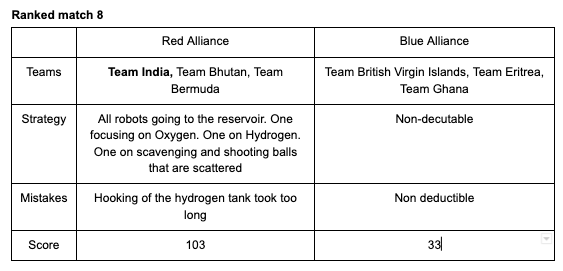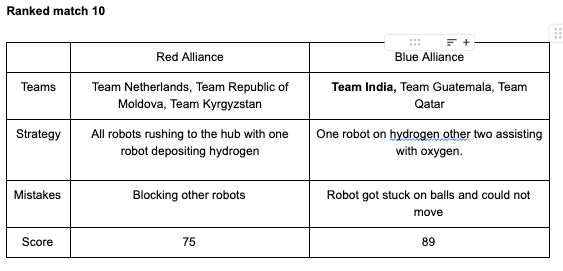The First Global Challenge is an International Robotics competition that brings high school students worldwide to collaborate and solve global problems using robotics. One team is selected from each country, with over 192 countries participating. Each year, teams are given a specific challenge related to a global issue, such as access to clean water or climate change. This year, the challenge was Hydrogen Horizons. The teams then design, build, and program a robot to complete tasks related to the challenge. The competition emphasises the importance of science, technology, engineering, and mathematics (STEM) education and promotes teamwork, diversity, and problem-solving skills. The event also features cultural exchange activities and opportunities for students to network with their peers and industry professionals.
Here is journey of Team India at the First Global Challenge 2023.
Day 1:
After arriving at the competition area, we started setting up our stall. We hung all our banners, which explained the details of our robot, outreach activities and team, on the stall walls. We laid out gifts and souvenirs for visitors and other teams to take on our table and kept our robot in the corner. We also set up our printing service area for other teams to print their files.
Next, we started setting up our robot. During transport, a few parts of our robot had been slightly damaged; we fixed all the issues and checked every robot mechanism.
While setting up our robot, the news channel CNA wanted to interview and take a small clip of us. So we stood around our robot and talked about our team.
By now, the practice fields had been set up. We decided to see if there were any practical issues with our robot and to check the accuracy of our human player in throwing the oxygen balls.
While practising, we realised two significant issues.
- The accuracy of the human player
- The lifting function of the robot.
Whenever the human player threw a ball into the oxygen accumulator, it would bounce back out because of the presence of horizontal slats. The bouncing of the balls meant that almost half the balls the human player threw would return.
But we were prepared for this, and instead of worrying about it, we started focusing on how to fix it. We changed our throwing technique to improve the angle and were able to raise the accuracy.
However, for the second error, we could not fix it in time, and the playfield was closed for the day.
Practicing (robot + throwing)
Day 2
After arriving at the venue, all the teams were collected for the Driver’s Meeting. In the meeting, we were explained all the rules and specifics of the competition.
After the meeting, our robot was inspected to ensure it followed all the rules and regulations. The inspector passed our hardware; however, they blocked our software due to a few settings and precautions not being followed. Luckily, we could sort out the issues quickly, and our robot was passed.

After this, we did driver and human player practice to adjust to the new fields.
We then started working on robot climbing, a significant issue for us. The main problem was that the beam the robot had to climb on was of a different measurement and material than the one we had built on our practice field back home. Because of this, the beam would bend, and the robot could not climb high enough. However, once we began solving the problem, the practice field was shut down, and we were no longer allowed to practise.
The formal opening ceremony was the exciting part of the day as we were dressed in the traditional costumes and were part of the parade of nations. In this parade, each country’s team would walk past the main stadium waving their flags while being recorded.
Day 3
We reached the arena in the morning and saw that the official fields were open for practice. So we went there for a practice match. Considering this was our first match, we did pretty well, but it provided valuable insight into how things would be during the match in the following days.
After we finished the practice, we immediately got to fixing the problem with our climber. We had a vague idea about not fitting in the beam but wanted to diagnose it further, so we analysed the problem. We first thought that the problem was that the lower beam prevented the robot from rising enough for the robot to be counted as climbing. So we removed that.
However, while fixing the problem, a few judges came to our stall to interview us. We rushed to our stalls and prepared for the presentation. This was our first presentation, so we were very nervous, but we could answer all the judges’ questions as we had practised for this moment. The judges asked many questions, ranging from fundraising to technical questions. This interview even led us to win the Safety Award. The judges were impressed by the fact that we gave medic kits to all the teams and visitors. On top of that, we were also handing out safety leaflets and manuals.
We wanted to test our new climber in a practice match, so we lined up and tried it. The change mainly worsened the issues and was not helping at all.
After the practice match, we made a closer diagnosis of the problem. It turned out that the problem was the latching of the robot to the beam. We tried a few different changes to improve the latching.
To test out the final working version of the climber, we went for another practice match.
The results of the changes were fruitful as we finally got the climber working and a last practice before our ranking matches.
After lunch, the ranking matches began.
Ranking 1:
Our alliance was Rwanda and the Marshall Islands. Our opponent won last year’s robot challenge, Kazakhstan, who were paired with the Cayman Islands and Burkina Faso. It was a tough match, as expected. We had a lot of friction in the alliance itself, as everyone was nervous. In the end, we lost 95–43, but we still had much to learn from this match.

After the competition was closed for the day, we had a cultural dinner at the Gardens by the Bay. We had lots of fun there, from exploring the flower dome to the Avatar experience; everything was beautiful.
Overall, this day was very hectic but mainly Productive since this allowed us to unleash our full potential in the coming matches.
Day 4
We came to the competition today ready to rock. We had six ranking matches today and barely 30 between each. We knew we would be in a time crunch, but we were determined to win anyway.
Ranking match 2
After our first win, we returned to our stall in high moods and saw that the judges had come again to interview us. Like last time, we were nervous but could answer them. We managed to answer all their questions; however, one of their questions was something that we needed to prepare for, so we had to improve on the spot.

Ranking match 3
After this overwhelming win in match 3, we felt like nothing could stop us.

Ranking match 4
In contrast to the last match, this match gave us a dose of reality.

Ranking match 5
With another overwhelming win, we were very close to being overconfident, but we learned our lesson last time.

After this match, we got a brainwave. We realised that the reason we were scoring less points was that our robot was focusing too much on oxygen. However, of the 15 or so balls our robot picked, The human players could throw only 5 in the oxygen accumulator. We realised that we needed to focus more on hydrogen.
After looking closely at our matches, we realised that our robot was barely filling up its hydrogen tank, but its oxygen tank was overflowing. So we decided to throw out all the oxygen on the field when it was picked up. This would allow us to pick up more balls and get more points.
Ranking match 6
With this match, we confirmed that our change was correct and
started making significant modifications to the design of our robot. We never worried about failure and only thought of evolution. With only 30 minutes to complete the changes, we had to hurry. But with all of us working together as a team, we were able to make it in time.

Ranking match 7
This match proves that to win, a team should be able to evolve on the spot without worrying about consequences.

Day 5
Today, we came ready to win with the new changes in our robot.
Ranking match 8

Ranking match 9

Ranking match 10

After all the ranking matches, we were ranked 17th overall.
This led us to be placed in alliance number 8, which consisted of the teams ranked 8, 16, 17 and one randomly picked team.
We were paired with Poland (rank 8), Jordan (16) and Ukraine (53). Although there were four teams, we could only use 3 per match; however, each team had to play at least once, so we couldn’t make Ukraine sit out every match.
After finding our alliance partners, we immediately got to discussing our strategies. We figured out the strengths of each robot and the weak points of each robot. This led us to develop a proficient plan, taking the best attributes of each robot while negating as many cons as possible.
With our strategy set, we were ready for the matches; however, before the semifinals, there was an award ceremony, which surprised us. We were still determining which awards we were about to win. We won the Helping Hand award and were placed 2nd for the fundraising award. We were filled with joy and celebrating this achievement.
Then we went on to queue for the first semis. The entire team was nervous since our opposing alliance was powerful. But we gave our best. At the beginning of the match, our robot did not start, which delayed our start.
We had a defeat in this match with a 121–88.
We discussed our problems, especially our robot not starting on time. While discussing the strategy, we even did robot maintenance to ensure no problems were faced in the next match.
Because of the excitement, we did not realise when the time had flown as it was time for our next semifinal round.
The second match was against the Highest-ranking team not only this year but also from last year’s challenge. This match was better than our previous match even though we faced a defeat in this match with 189–126. Our strategy was executed much better and smoother. After the match, we again discussed things that went out of the plan and how to ensure they didn’t happen the next match, and of course, we ran maintenance on the robot.
The third match was a disaster. From the moment it started, the robot started swaying, and in an attempt to fix it, the battery levels dropped to critical levels. Since the motors couldn’t get enough energy, the robot slowed down and couldn’t correctly pick up balls. When we went to deposit the balls, the mechanisms all failed, and broken pieces flew off our robot.
We lost 96–58
For the fourth match, the question of which team should sit out instead of Ukraine arose. It was unanimously decided to be us.
The next match was our only win at the semifinals with a 102- 113.
This helped us learn that sometimes, things don’t go your way. Sometimes, you face bad luck, even worse allies, and the worst failures.
But despite it all, one should keep struggling, Keep trying, Keep evolving and finally, win.
Thats about the Team India robot match journey for FGC 2023
Comments
Post a Comment